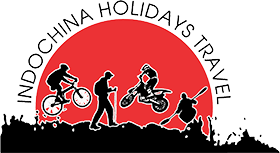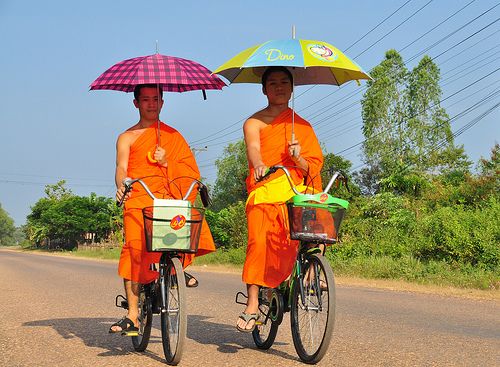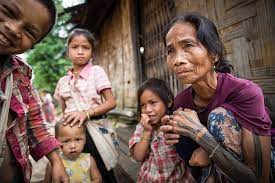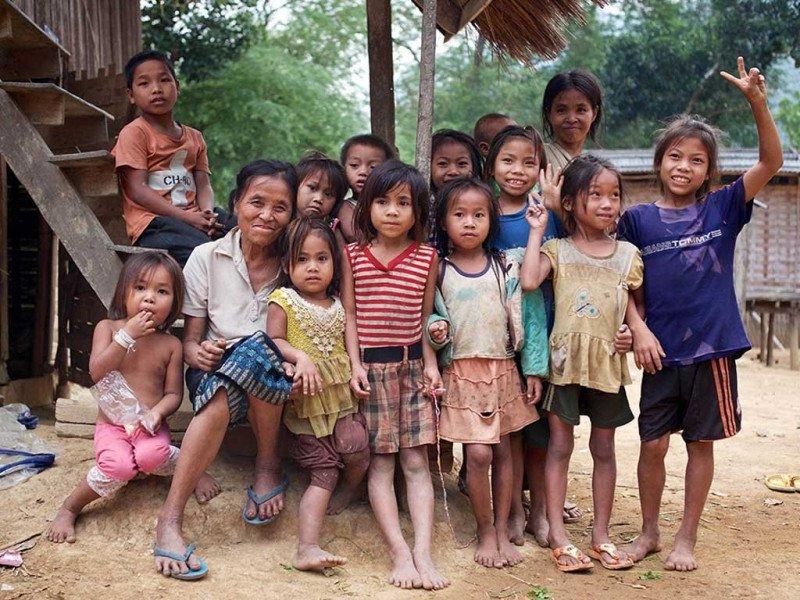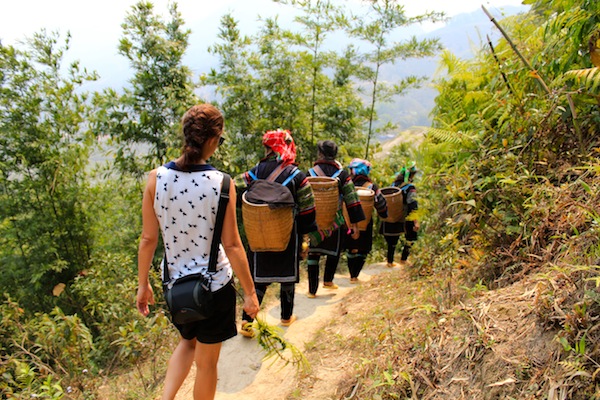Day 1 : Luang Prabang Arrival
Luang Prabang through small mountains, mostly forested but with limestone low cliffs - a strange land, indefinable and already mysterious. Then there is the Mekong - twisting its way between hills with palm trees, houses and a temple a hill before you touch down at the small airstrip. You will be met and transferred to your hotel. The afternoon is at leisure. Your hotel is close to the town centre so you may wish to venture out for a little exploration.
Overnight: Villa in Luang Prabang
Day 2: Full day sightseeing in Luang Prabang including alms giving to monks, Royal Palace visit and walking tour. Visit the night market. ( B, L )
This morning your guide will pick you up just before dawn to make a pre-breakfast trip into town to see the monks collecting their alms from the local people. In the quiet of the early morning, it is a memorable sight to see more than 100 monks walking through the streets, past the temples and shops, to collect their packets of rice and other foodstuffs for the day, from residents who line the roadside. You will then return to your hotel for breakfast.
After breakfast, you will visit the Royal Palace, which stands on the edge of the Mekong and is now a museum. It was built in 1904 for King Sisavang Vong. Whenever official visitors came to Luang Prabang, they came upriver and the king would meet them at the riverside entrance to his palace. His son was prevented from taking the throne by the 1975 revolution and he and his wife were exiled to a cave in northern Laos where they died from starvation. The museum is full of the most precious works of art collected by the royal family over many generations. There are many items in the collection that were gifts from early explorers or diplomats., Right opposite the Royal Palace is the Hill of Phousi. This is the temple on the hill that you would have seen on the flight in and it is well worth the 20 or 30-minute climb, and is especially breathtaking at sunset.
After visiting the palace you will have a comprehensive walking tour of the old quarter of Luang Prabang. In 1995, Luang Prabang was voted a World Heritage city, and on your tour, you will see the best parts including Vat Xiengthong, Vat Vixoun, Vat Sene, and Vat Mai. You will either have lunch in town or return to your hotel for a bite to eat., In the evening your guide will take you to the night market. This will come as quite a surprise as virtually the whole of the main street is closed off to traffic and stalls are erected up and down the street selling anything and everything. It's a great opportunity for some souvenir hunting.
Overnight: in Luang Prabang,
Day 3: Cross the river to visit Pottery Village. Continue to Wat Long Khoune, walk to Wat Chomphet and Xieng Mene Village ( B, L )
Today you will cross the Mekong river to see village life in the quiet villages on the opposite bank away from the hurly-burly of Luang Prabang. Firstly you visit the village of Bang Chang, where the locals are famed for their skills in pottery making. It is interesting to watch the local master craftsmen at work and especially interesting to see their huge and impressive outdoor kiln. You will also see some of the many types of pots they make here. Most of their products are rather too large to be bought for souvenirs.
You will then travel on to visit Wat Long Khoune near the village of Chompet. Wat Long Khoune is important in the history of Laos as in ancient times it was customary for a new king to spend three days in retreat here before being crowned - a retreat involving ritual baths, meditation and reflection. Near here is a large limestone cave complex containing many old statues of the Buddha.,From Wat Long Khoune you climb steeply up steps to the ridge above, where the pretty village of Wat Chomphet is situated. At the top of the steps are a small temple and two stupas that house the bones of the wives of one of the former kings of Laos. There are excellent views from here over the river and back towards Luang Prabang.
From here you walk to the village of Xieng Mene, a sleepy but rather beautiful village full of traditional houses and said to date back to the 14th century. The temple at Xieng Mene was extensively rebuilt in 1927, though it still retains its beautifully carved doors. This temple is considered particularly important, as it once housed one of the main treasures that now reside in the Royal Palace, a golden Buddha statue that was twice taken out of the country to Thailand. The statue was kept in this village on its way back to Luang Prabang from Vientiane in 1867. You will have lunch in a restaurant back in Luang Prabang and the rest of the day will be at leisure.
Overnight: in Luang Prabang,
Day 4 : Boat trip from Luang Prabang to Pak Ou. Visit Pak Ou Caves. Drive to Nong Khiaw. Walking tour of the village ( B, L )
Today after breakfast you will drive to the river port and board your traditional riverboat to travel upstream along the Mekong River through beautiful scenery. You will see plenty of life going on along the river banks - vegetables are grown in gardens down to the water's edge, water buffalo graze and people fish both with nets from canoes and with static bamboo fish traps. You may also see people panning for gold. After about 2 hours you reach the confluence of the Nam Ou River with the Mekong River. You will have lunch in the restaurant which overlooks this stunning spot and then visit the sacred Pak Ou Caves which are situated just at this confluence. These caves are set in massive limestone cliffs and house thousands of statues of Buddha. There are two caves, a lower and an upper one, both of which are worth visiting. The king and his entourage used, in the olden days, to row upriver once a year to make an overnight pilgrimage. It was the king who first started the tradition of placing Buddhas of all shapes and sizes in the caves. Now there are over 2,000 Buddha images in Pak Ou caves. There is also an enjoyable short walk around the back of the caves to visit the village of Ban Moung Keo. You will notice here locals selling caged birds - you may buy these to release for good karma, but be warned they will soon either return to their captor or be caught again!, At this confluence, you leave the Mekong River to drive up the valley of the Nam Ou River through an increasingly stunning landscape of limestone cliffs and peaks. The scenery along the way is delightful - a string of forested mountains like Chinese paintings, some of the course with smouldering fires. You arrive at the small town of Nong Khiaw, situated at the foot of breathtaking, karstic limestone mountains next to the Nam Ou River, and after checking in at your hotel, there will be time for a walk around the village.
Overnight: in Nong Khiaw,
Day 5 : Drive Nong Khiaw to Luang Nam Tha - 7 hours ( B , L )
Before you set off today you should have had time to make a quick visit, just a short distance away from Nong Khiaw, to see the limestone cave of Pathok, once used for shelter during the Indo-China War. These caves are situated at the foot of some quite impressive limestone cliffs. Some of the original rickety bamboo ladders by which they were originally reached remain although nowadays there is a more sturdy metal staircase as well. The caves do not open till later so you will probably only be able to see them from outside, but it is a delightful stroll to reach them. You will then set off for the drive to Luang Nam Tha. You will reach the town of Oudomxai, a crossroads for trade through the region, and will probably have lunch in a local restaurant there. From Oudamxai the scenery is beautiful and you should arrive at Luang Nam Tha around sunset, ending your day at the eco-friendly Boat Landing Guest House. This lodge first opened in 1999, initially being the brainchild of Bill Tuffin, an American development worker, but now owned and run by local people. The lodge is situated just outside town on the banks of the Nam Tha River, within a small wildlife reserve, so you should see a few birds here.
Overnight: in Luang Nam Tha,
Day 6: Tuk-tuk ride to Nam Ha National Protected Area. Nature walk through jungle terrain to Ban Chalernsouk Village - 5-6 hours. Return to Luang Namthan ( B , L)
Today begins with a tuk-tuk ride out of Luang Namtha. Your first stop will be to collect some supplies from a local market before continuing to Phieng Ngam Village. Here you can see an array of handicrafts being produced by the local craftspeople.
Around mid-morning, you will arrive at the start of your walking trail and being to gradually ascend the densely forested hills. During the walk, you will make frequent stops so that your expert guide can identify the plants and trees that you encounter and tell you how they are used by the local, indigenous people. At lunchtime, your guide will look for a suitable location to stop and prepare a delicious Lao picnic lunch using both the supplies you collected earlier and the natural resources of the jungle. It will be a unique experience.,After lunch, you continue on the trail, immersed deep in wild primary jungle which, before long opens into a rich mosaic of cultivated lands. Around mid-afternoon, you reach the end of your hike at Ban Chalernsouk, a remote highland village of the Khmu people. You will have time to explore before taking a tuk-tuk ride back to Luang Namtha.
Overnight: in Luang Nam Tha,
Day 7: Boat trip visiting Ban Mai and Ban Sopdut. Drive to Muang Sing - approximately 1½ hours ( B, L )
Again a local guide will take you on a trip up the Nam Tha River to enter the Nam Tha National Bio-diversity Conservation Area. The Nam Tha National Bio-diversity Conservation Area is one of twenty-one conservation areas around the country established in 1993 and approximately 12% of the nation's land is encompassed by these national areas. Each area has a plan for forestry management and the preservation of wildlife. The area is home to a variety of animals, plants and birds including tigers, the beautiful clouded leopard, macaques, pangolins, wild Asian elephants, Asiatic black bears, Malayan sun bears, gaur and wild boar and though you may see scat and footprints along the trail, sightings of the larger mammals are rare. Twenty-five villages lie within the NPA and as well as using the forest for their daily subsistence needs, they also protect it, recognising the need to sustain it for future use.
Two villages are visited along the way, firstly the Khmu village of Ban Sopsim and later the Lanten village of Ban Sopdut. The Nam Tha River begins approximately 15 km north of Luang Nam Tha at the confluence of the Nam Luang and Nam Toung rivers. The first village downstream is Ban Mai. The people here are Thai Dam whose homeland is Dien Bein Phu in northern Vietnam. It is believed that they first came here during the 1890s in response to the marauding 'Black Banner', Chinese bandits from Yunnan. Boatmen sometimes stop here to take on local boatmen to help navigate the river. Silk is produced by some households on this river and look out for the bamboo baskets and trays containing worms and bright yellow cocoons under some of the houses.
After leaving the plains the river runs through forest-covered hills and passes several Lanten villages. They are sometimes also referred to as Lao Huay. The Lanten are a more reserved, shy people who look more akin to Tibetans than Chinese. They are recognised by their dark indigo clothing which is woven and dyed in the village and by the striking silver jewellery of the women. At the end of childhood, Lanten women shave their eyebrows. The male elders continue to read and write a Lanten script based on Chinese characters. Again, they follow Animism and ancestor worship. Lantens sometimes use wooden masks in their rituals. They often make paper in frames to dry by the river banks of their villages.
At the end of the day, you will make the drive to Muang Sing. This takes about an hour and a half. It is a scenic drive on a twisting road in the mountains, in places almost gorge-like. Eventually, you emerge out of the hills and descend towards a large plain covered in paddy fields to arrive at Muang Sing.
Overnight: in Muang Sing
Day 8: Walk between Houyla and Houy Khem villages - approximately 4 hours. ( B, L )
At one time the town of Muang Sing was enclosed by a large, high, square, fortified wall, made of compacted mud. This has largely disappeared now but parts of it can still be seen if you hunt around town. There is a market, a museum in what was the governor's house at one time, one hotel, several small guest houses, a police station and a tourist office. The morning market is very colourful and well worth getting up early to have a look at. The tourist office will supply a local guide today to take you on your walk. A visit to the tourist office is quite interesting - there are maps, diagrams, notice boards, photos and posters showing statistics of how many people have visited each year. From Muang Sing, you drive out for about half an hour to the start of the walk from the very lively and friendly village of Hyla. Here you are likely to see many cheerful ladies wearing full Akha costumes and carrying their babies on their backs. They do their weaving, spinning and other chores out in the open air. Before you leave the village your guide may be able to arrange a visit to a local house. These houses are often quite spacious, with large and airy rooms, with a hearth for cooking at one end, living space or guest accommodation at the other and a separate room for the family to sleep in off this main room. At the hearth, there may be two separate fires, one for cooking meals for the family and one for cooking up vegetables and mash for the family pig. These pigs may provide either valuable additional income for the family or the rare chance for the family to eat meat on festival occasions. The family may also own some nicely made tribal cooking pots, baskets for individual portions of sticky rice for use at festivals, wooden boards for the drying of sticky rice, chopping boards and various other utensils.
The walking today is mostly flat and quite easy. You take a path out, past a small lake and across a dam and then through cultivated fields of rubber trees. Before you reach the village of Houyna you pass one of the most elaborate spirit gates of the trip. It is decorated with knives, guns and even an American rocket, all to keep bad spirits out of the village. You then pass through the village of Houyna with its fancy Japanese funded school. You leave Houyna by a dirt road but soon take a footpath, again through fields, to the village of Nasay, a White Hmong village, which is differentiated from Akha villages by having its houses built directly on the ground and not on stilts. You then continue, through plantations of bananas to the Akha village of Houy Khem, arriving in time for lunch (possibly on the veranda of the house of the village headman) with typical provisions including bamboo shoots, fried pork, sticky rice, chilli dip and sweet potato in the batter.,You rendezvous with your transport to take you back to Muang Sing. This evening there is the added treat of a visit to a local sauna for a herbal massage.
Overnight: in Muang Sing
Day 9: Morning in Muang Sing. Drive to Luang NamTha - 2 hours ( B, L)
This morning you will have time to the exploration of Muang Sing before you leave for Luang Nam Tha. Muang Sing was formerly a garrison town under the French and you can still see the remains of the old garrison buildings not far from the hotel. In addition, you can still see the remains of the old town walls and not far away is also the old French cemetery, now almost reclaimed by the jungle. It is interesting to see how quickly the old walls and cemetery are being swallowed by the jungle.
If you are up and about early you may visit the local market while later you may visit one of several local temples. For instance, at the end of the high street, there is a large Buddhist temple, Wat Xieng Jai, quite different to the temples you will already have been to in Luang Prabang. The temple has a very high roof and hanging down, are large, colourful streamers which the people believe the spirits use to climb to heaven. Very often there are offerings to the spirits made from cane lying on the ground outside the temple.
The local tribal museum is also well worth a visit. This museum, just along the street from the tourist office, is set in a former mansion and is surprisingly good and informative. There are excellent displays of tribal costumes and artefacts and it all gives you a good introduction to some of the tribal people you will have met out in the villages.
In the afternoon you will drive to Luang Nam Tha, approximately 2 hours.
Overnight: in Luang Nam Tha,
Day 10: Free time in Luang Nam Tha. Fly to Vientiane ( B, L )
You will have some welcome free time this morning when you can watch the world go by on the river bank, or spend some time bird watching.,After lunch, you will be transferred to the airport for your flight to Vientiane. In Vientiane, you will have time for a short orientation tour before walking along the banks of the Mekong River for the sunset.
Overnight: in Vientiane,
Day 11: Sightseeing in Vientiane. ( B, L )
Today you will have half-day sightseeing of Vientiane, including the morning market, Wat Sisaket, Ho Phra Keo Museum and That Luang Stupa as well as the Victory Arch which you pass on the way to That Luang Stupa. The capital of Laos used to be Luang Prabang but was moved to Vientiane, by the French. Vientiane with a population of approximately 200,000, is a much larger, more cosmopolitan city than Luang Prabang but it is still hard to believe that this laid back place is a capital city. It retains a small-town feel and has some very fine French colonial architecture as well as many large, elaborate temples. Strangely, much of the city is built in straight lines and in between the wonderful temples, there is third world, low rise, concrete shops, flats and offices alongside plenty of greenery. It is also well worth driving or walking along the riverfront - the other side is Thailand. The afternoon is free for relaxing and packing.
Day 12: Vientiane - Departure ( B )
Pick up and transfer to airport for departure. End The Tour.
Please consider the environment before printing
Tour price: Contact Us
Group size: 2 to 25 pax
Departure date based on your inquiry
Tour Cost Includes:
- Meals in tours :L =Lunch , D = dinner , B = breakfast
- Accommodation in tour - 11 nights
- Lunch in Midway restaurant/City Restaurant or Pack Lunch
- Flight ticket from Luang Namthan to Vientiane
- Boat trip, local ferry in tour
- Back up AC vehicle for the complete tour ( Bus, + Truck for the group )
- English speaking Local Guide - Cum trekking guide
- Fresh Fruits/Snacks (Only trekking part)
- Unlimited filter water during trekking (Only trekking part)
- Entrance fees and permissions
- Driver Allowance
- Toll and Parking charges
- 10% Government Taxe
Tour Cost Excludes:
- All flight tickets to and departure from Laos
- Visa to Laos ( Upon arrival )
- Other personal expenses
- Meals not on tour
- Accommodation not on tour
- Tips and Gratitude
- Travel insurance
- Any Hard and Soft Drinks with meals
